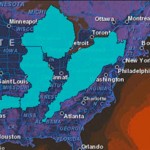- The red areas of the map show where natural gas deposits are in the nation. (Photo courtesy of U.S. Geological Survey)
WASHINGTON – Lawmakers are pushing to give states more authority to regulate hydraulic fracturing, as debate continues over whether the natural gas drilling causes earthquakes.
Rep. John Delaney, D-Md., is taking a cautious approach. “Most of those bills erode federal standards and I think federal standards are important,” he said.
If legislation under consideration on Capitol Hill passes, states will have more jurisdiction over federal land where drilling occurs. Currently, drilling companies must meet federal standards for clean air and water. States determine the extent of regulation of nonfederal land within their own borders.
The Marcellus Shale region, in Maryland’s Garrett and Allegany counties, has already been targeted as a natural gas-rich area for potential drillers in the state. Should hydraulic fracturing begin in Maryland, and drilling spreads to federal lands within the state, the proposed legislation would give the state power to regulate drilling on that land as well.
Hydraulic fracturing, more commonly known as fracking, is the process by which sand, water and chemicals are injected into the ground to release natural gas from shale deposits. Expanded use of natural gas would provide the country with a cleaner source of fuel that’s better for the environment.
On the federal level, the Environmental Protection Agency is conducting a national study to examine if fracking has an impact on drinking water resources. There is fear of contamination from chemical mixing or improper waste disposal. The final EPA study will be released for peer review later this year.
While the EPA is not examining the effects of fracking on seismic activity, preliminary findings by U.S. Geological Survey studies have found that increased injection of wastewater into the ground during fracking has coincided with greater seismic activity. There’s no confirmation, however, that fracking has caused any high magnitude earthquakes.
On Friday, Ohio imposed new, stricter permit conditions on companies after increased seismic activity was detected in the state.
The new Ohio permit conditions require drilling sites to be more than three miles from any known fault or epicenter of seismic activity of a magnitude of 1.0 or greater, according to Bethany McCorkle, a spokeswoman for the Ohio Department of Natural Resources.
These conditions will apply to future permits, as well as to about 400 permits that have already been granted, but where drilling has not yet begun. The state natural resources agency will review permits that have already been issued to ensure the distance requirements are met, McCorkle said.
According to the U.S. Geological Survey, an estimated 1.3 million earthquakes of magnitude 2.0 to 2.9 occur every year in the United States.
“They can’t all be caused by oil and gas activity,” Tom Stewart, executive vice president of the Ohio Oil and Gas Association said.
“The ODNR [Ohio Department of Natural Resources] has a responsibility to protect the public interest and we support that,” Stewart said. “Not sure that there is a correlation, but it’s worth looking into.”
The permit conditions in Ohio will affect a large portion of Stewart’s association’s members. Stewart said that fracking regulators should remember that many earthquakes relate to human activity.
“No one is suggesting that the Seattle Seahawks no longer play football,” Stewart said, referring to a couple instances where fans at the football team’s games apparently caused low magnitude earthquakes with their cheering. “A lot of things cause induced seismicity,” Stewart said. “Perspective is the biggest problem.”
Rep. Louie Gohmert R-Tex. sponsors the proposed federal legislation in the House and Sen. James Inhofe R-Okla sponsors a similar bill in the Senate.
Back in Maryland, Delaney wants to push for federal health and safety standards for fracking. “There should be federal oversight,” Delaney said. “Then it should be up to local communities to decide.”



